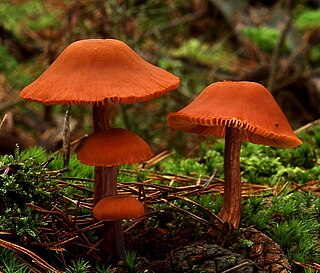
Laccaria laccata, commonly known as the deceiver, lackluster laccaria, or waxy laccaria, is a white-spored species of small edible mushroom found throughout North America and Europe. It is a highly variable mushroom, and can look quite washed out, colorless and drab, but when younger it often assumes red, pinkish brown, and orange tones. The species is often considered by mushroom collectors to be a 'mushroom weed' because of its abundance and plain stature.

Hygrophoropsis aurantiaca, commonly known as the false chanterelle, is a species of fungus in the family Hygrophoropsidaceae. It is found across several continents, growing in woodland and heathland, and sometimes on woodchips used in gardening and landscaping. Fruit bodies (mushrooms) are yellow–orange, with a funnel-shaped cap up to 8 cm across that has a felt-like surface. The thin, often forked gills on the underside of the cap run partway down the length of the otherwise smooth stipe. Reports on the mushroom's edibility vary – it is considered poisonous, but has historically been eaten in parts of Europe and the Americas.

Leratiomyces ceres, commonly known as the chip cherry or redlead roundhead, is mushroom which has a bright red to orange cap and dark purple-brown spore deposit. It is usually found growing gregariously on wood chips and is one of the most common and most distinctive mushrooms found in that habitat. It is common on wood chips and lawns in North America, Europe, Australia, New Zealand and elsewhere. The name Stropharia aurantiaca has been used extensively but incorrectly for this mushroom.

Gymnopilus luteofolius, known as the yellow-gilled gymnopilus, is a large and widely distributed mushroom that grows in dense clusters on dead hardwoods and conifers. It grows in late July to November in the east and in the winter on the west coast of North America. It has a rusty orange spore print and a bitter taste.

Cyptotrama asprata, commonly known as the golden-scruffy collybia or spiny woodknight is a saprobic species of mushroom in the family Physalacriaceae. Widely distributed in tropical regions of the world, it is characterized by the bright orange to yellow cap that in young specimens is covered with tufts of fibrils resembling small spikes. This fungus has had a varied taxonomical history, having been placed in fourteen genera before finally settling in Cyptotrama. This species is differentiated from several other similar members of genus Cyptotrama by variations in cap color, and spore size and shape.

Mycena haematopus, commonly known as the bleeding fairy helmet, the burgundydrop bonnet, or the bleeding Mycena, is a species of fungus in the family Mycenaceae, of the order Agaricales. It is widespread and common in Europe and North America, and has also been collected in Japan and Venezuela. It is saprotrophic—meaning that it obtains nutrients by consuming decomposing organic matter—and the fruit bodies appear in small groups or clusters on the decaying logs, trunks, and stumps of deciduous trees, particularly beech. The fungus, first described scientifically in 1799, is classified in the section Lactipedes of the genus Mycena, along with other species that produce a milky or colored latex.
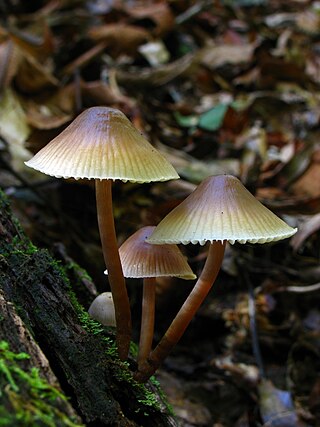
Mycena galericulata is a mushroom species commonly known as the common bonnet, the toque mycena, the common mycena or the rosy-gill fairy helmet. The type species of the genus Mycena was first described scientifically in 1772, but was not considered a Mycena until 1821. It is quite variable in color, size, and shape, which makes it somewhat difficult to reliably identify in the field. The mushrooms have caps with distinct radial grooves, particularly at the margin. The cap's color varies from grayish brown to dark brown and the shape ranges from bell-like to bluntly conical to flattened with an umbo. The stem is hollow, white, tough and thin, without a ring and often roots deeply into the wood on which it grows. The gills are white to grayish or even pinkish when mature and are connected by distinct cross-veins. The caps can reach 4 cm (1.6 in) in diameter, and have a mealy odor and taste. The spore print is white and the gills are pink at maturity, which can lead to possible confusion with species of the genus Pluteus. M. galericulata mushrooms grow mostly in clusters on the well-decayed stumps of deciduous and coniferous trees from spring to autumn. The species can generally be considered inedible. It is common and widespread in the entire temperate zone of the Northern Hemisphere, but it has also been reported from Africa.
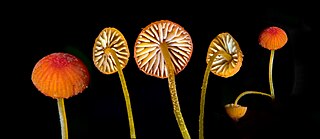
Mycena acicula, commonly known as the orange bonnet, or the coral spring Mycena, is a species of fungus in the family Mycenaceae. It is found in Asia, the Caribbean, North America and Europe. The fruit bodies, or mushrooms, of the fungus grow on dead twigs and other woody debris of forest floors, especially along streams and other wet places. They have small orange-red caps, up to 1 cm (0.4 in) in diameter, held by slender yellowish stems up to 6 cm (2.4 in) long. The gills are pale yellow with a whitish edge. Several other Mycena species look similar, but may be distinguished by differences in size and/or microscopic characteristics. M. acicula is considered inedible because of its small size.
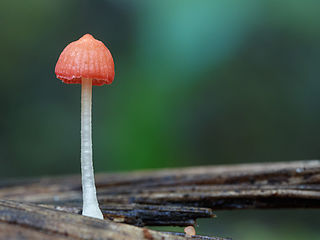
Atheniella adonis, which has the recommended name of scarlet bonnet in the UK, is a species of agaric in the family Cyphellaceae. Found in Asia, Europe, and North America, it produces small orangish to reddish mushrooms with caps up to 1.2 cm (0.5 in) in diameter and thin pinkish-white stems reaching 4 cm (1.6 in) long. The fungus typically grows in conifer woods and peat bogs, suggesting a preference for acidic environments. The appearance of several atypical fruitings on deciduous wood in the Netherlands in the late 1970s was attributed to increases in atmospheric pollution that raised the acidity of the wood substrate.
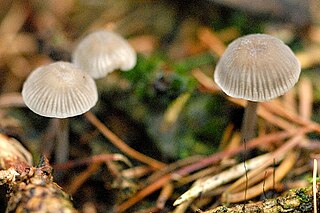
Mycena cinerella, commonly known as the mealy bonnet, is an inedible species of mushroom in the family Mycenaceae. It is found in Europe and the United States, where it grows in groups on fallen leaves and needles under pine and Douglas fir. The small grayish mushrooms have caps that are up to 1.5 cm (0.6 in) wide atop stipes that are 5 cm (2.0 in) long and 2.5 mm (0.10 in) thick. Its gills are grayish-white and adnate, with a "tooth" that runs slightly down the stipe. The fungus has both two- and four-spored basidia. As its common name suggests, it smells mealy.

Mycena inclinata, commonly known as the clustered bonnet or the oak-stump bonnet cap, is a species of mushroom in the family Mycenaceae. The doubtfully edible mushroom has a reddish-brown bell-shaped cap up to 4.5 cm (1.8 in) in diameter. The thin stem is up to 9 cm (3.5 in) tall, whitish to yellow-brown at the top but progressively becoming reddish-brown towards the base in maturity, where they are covered by a yellowish mycelium that can be up to a third of the length of the stem. The gills are pale brown to pinkish, and the spore print is white. It is a widespread saprobic fungus, and has been found in Europe, North Africa, Asia, Australasia, and North America, where it grows in small groups or tufts on fallen logs and stumps, especially of oak. British mycologist E.J.H. Corner has described two varieties of the mushroom from Borneo. Lookalike species with which M. inclinata may be confused include M. galericulata and M. maculata.
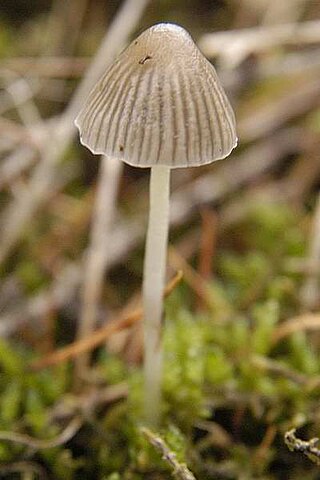
Mycena leptocephala, commonly known as the nitrous bonnet, is a species of fungus in the family Mycenaceae. The mushrooms have conical grayish caps that reach up to 3 cm (1.2 in) in diameter, and thin fragile stems up to 5 cm (2.0 in) long. The gills are gray and distantly spaced. The spores are elliptical, typically measure 7–10 by 4–6 μm, and are white in deposit. When viewed under a light microscope, the gills have abundant spindle-shaped cystidia on the gill edges, but few on the gill faces. The mushroom is found in North America, Asia, and Europe where it grows singly or in groups on conifer needles, cones and sticks on the forest floor. It has a distinctive odor of bleach; the edibility is unknown. Similar species include Mycena alcalina, M. austera, and M. brevipes.

Mycena sanguinolenta, commonly known as the bleeding bonnet, the smaller bleeding Mycena, or the terrestrial bleeding Mycena, is a species of mushroom in the family Mycenaceae. It is a common and widely distributed species, and has been found in North America, Europe, Australia, and Asia. The fungus produces reddish-brown to reddish-purple fruit bodies with conic to bell-shaped caps up to 1.5 cm (0.6 in) wide held by slender stipes up to 6 cm (2.4 in) high. When fresh, the fruit bodies will "bleed" a dark reddish-purple sap. The similar Mycena haematopus is larger, and grows on decaying wood, usually in clumps. M. sanguinolenta contains alkaloid pigments that are unique to the species, may produce an antifungal compound, and is bioluminescent. The edibility of the mushroom has not been determined.

Panellus stipticus, commonly known as the bitter oyster, the astringent panus, the luminescent panellus, or the stiptic fungus, is a species of fungus in the family Mycenaceae, and the type species of the genus Panellus. A common and widely distributed species, it is found in Asia, Australia, Europe, and North America, where it grows in groups or dense overlapping clusters on the logs, stumps, and trunks of deciduous trees, especially beech, oak, and birch. During the development of the fruit bodies, the mushrooms start out as tiny white knobs, which, over a period of one to three months, develop into fan- or kidney-shaped caps that measure up to 3 cm (1.2 in) broad. The caps are orange-yellow to brownish, and attached to the decaying wood by short stubby stalks that are connected off-center or on the side of the caps. The fungus was given its current scientific name in 1879, but has been known by many names since French mycologist Jean Bulliard first described it as Agaricus stypticus in 1783. Molecular phylogenetic analysis revealed P. stipticus to have a close genetic relationship with members of the genus Mycena.

Mycena stylobates, commonly known as the bulbous bonnet, is a species of inedible mushroom in the family Mycenaceae. Found in North America and Europe, it produces small whitish to gray fruit bodies with bell-shaped caps that are up to 15 mm (0.6 in) in diameter. The distinguishing characteristic of the mushroom is the fragile stipe, which is seated on a flat disk marked with distinct grooves, and fringed with a row of bristles. The mushrooms grow in small troops on leaves and other debris of deciduous and coniferous trees. The mushroom's spores are white in deposit, smooth, and ellipsoid-shaped with dimensions of 6–10 by 3.5–4.5 μm. In the development of the fruit body, the preliminary stipe and cap structures appear at the same time within the primordium, and hyphae originating from the stipe form a cover over the developing structures. The mycelia of the mushroom is believed to have bioluminescent properties.

Mycena aurantiomarginata, commonly known as the golden-edge bonnet, is a species of agaric fungus in the family Mycenaceae. First formally described in 1803, it was given its current name in 1872. Widely distributed, it is common in Europe and North America, and has also been collected in North Africa, Central America, and Japan. The fungus is saprobic, and produces fruit bodies (mushrooms) that grow on the floor of coniferous forests. The mushrooms have a bell-shaped to conical cap up to 2 cm in diameter, set atop a slender stipe up to 6 cm long with yellow to orange hairs at the base. The fungus is named after its characteristic bright orange gill edges. A microscopic characteristic is the club-shaped cystidia that are covered with numerous spiky projections, resembling a mace. The edibility of the mushroom has not been determined. M. aurantiomarginata can be distinguished from similar Mycena species by differences in size, color, and substrate. A 2010 publication reported the discovery and characterization of a novel pigment named mycenaaurin A, isolated from the mushroom. The pigment is responsible for its color, and it has antibiotic activity that may function to prevent certain bacteria from growing on the mushroom.
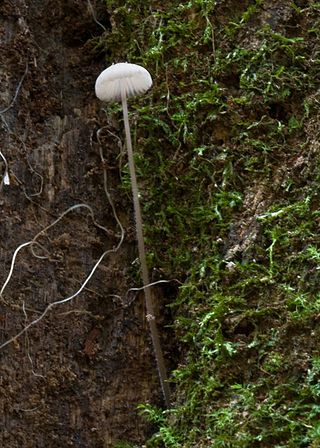
Mycena cystidiosa is a species of mushroom in the family Mycenaceae. Described as new to science in 1964, it is known only from New Zealand and Australia. The fruit bodies have a broadly conical small white cap up to 12 mm (0.5 in) wide, with distantly spaced cream-coloured gills on the underside. The stipe is particularly long, up to 20 cm (8 in), with an abundant covering of white hairs at the base. The species is known for its abundant rhizomorphs—long, root-like extensions of mycelia.
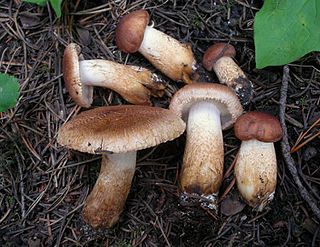
Tricholoma vaccinum, commonly known as the russet scaly tricholoma, the scaly knight, or the fuzztop, is a fungus of the agaric genus Tricholoma. It produces medium-sized fruit bodies (mushrooms) that have a distinctive hairy reddish-brown cap with a shaggy margin when young. The cap, which can reach a diameter of up to 6.5 cm (2.6 in) wide, breaks up into flattened scales in maturity. It has cream-buff to pinkish gills with brown spots. Its fibrous, hollow stipe is white above and reddish brown below, and measures 4 to 7.5 cm long. Although young fruit bodies have a partial veil, it does not leave a ring on the stipe.

Mycena purpureofusca, commonly known as the purple edge bonnet, is a species of agaric fungus in the family Mycenaceae. First described by Charles Horton Peck in 1885, the species is found in Europe and North America, where it grows on the decaying wood and debris of conifers, including cones. Fruit bodies have conical to bell-shaped purple caps up to 2.5 cm (1 in) set atop slender stipes up to 10 cm (4 in) long. The mushroom is named for the characteristic dark greyish-purple color of its gill edges. In the field, M. purpureofusca mushrooms can usually be distinguished from similar species by characteristics such as the dark purple gill edges, the deep purple cap center, and its cartilagineous consistency. The fungus contains a laccase enzyme that has been investigated scientifically for its potential to detoxify recalcitrant industrial dyes used in textile dyeing and printing processes.
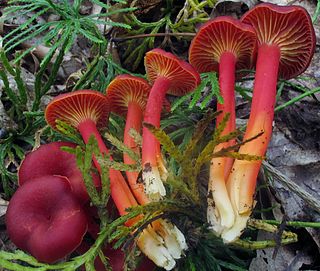
Hygrocybe appalachianensis, commonly known as the Appalachian waxy cap, is a gilled fungus of the waxcap family. It is found in the eastern United States, where it fruits singly, in groups, or clusters on the ground in deciduous and mixed forests. The species, described in 1963 from collections made in the Appalachian Mountains, was originally classified in the related genus Hygrophorus. It was transferred to Hygrocybe in 1998, in which it has been proposed as the type species of section Pseudofirmae.





















